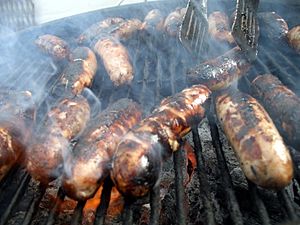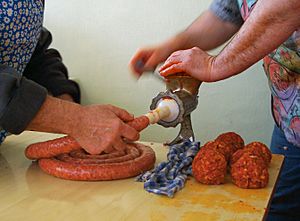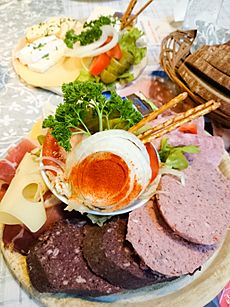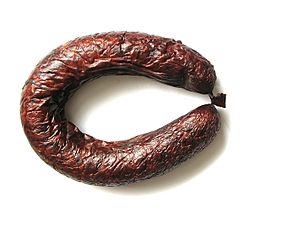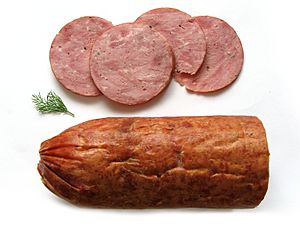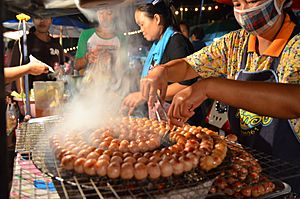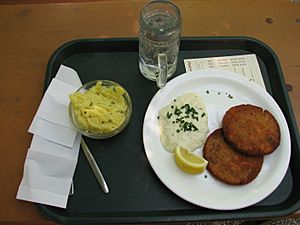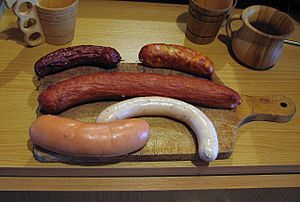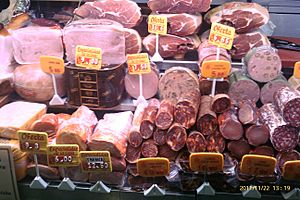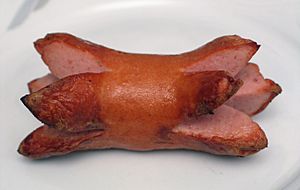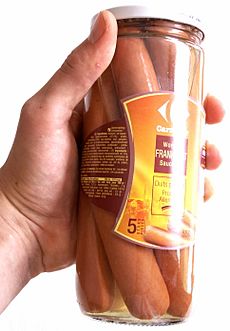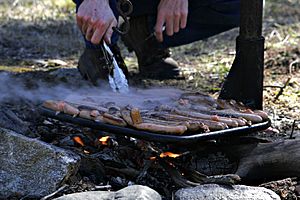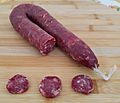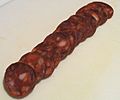Sausage facts for kids
A sausage is a food usually made from ground or chopped meat. It often has yummy spices mixed in and is wrapped in a special cover called a casing. Other foods like hot dogs, pepperoni, and salami are also wrapped in casings, just like sausages.
Sausages can be made from different parts of an animal, and some even contain blood. For example, sausages from Ireland and England often have a lot of breadcrumbs, making them less meaty than sausages from other places. You can eat sausages as a meal, in a sandwich, or even in other dishes like stews. Many countries have their own unique kinds of sausages. Sausages are actually one of the oldest prepared foods!
Contents
The History of Sausages
Sausage making started because people wanted to use all parts of an animal and keep meat fresh for longer. Long ago, people would salt meat scraps, organs, blood, and fat to preserve them. Then, they would stuff these mixtures into clean animal intestines. This created the classic sausage shape we know today. Because of this, sausages, puddings, and salami are some of the oldest foods ever made! They could be cooked right away or dried to last a long time.
Ancient records show that people were making sausage-like dishes thousands of years ago. An old tablet from the Akkadian language mentions intestines filled with a meat mixture. The Chinese sausage called làcháng, made from goat and lamb, was first talked about way back in 589 BC.
The Greek poet Homer wrote about a type of blood sausage in his famous story, the Odyssey. Another Greek writer, Epicharmus, even wrote a comedy play called The Sausage! This shows that sausages were very popular with both the ancient Greeks and Romans.
In ancient Italy, a famous sausage from Lucania (now Basilicata) was called lucanica. This name is still used for some sausages today. During the time of Roman Emperor Nero, sausages were part of a festival called Lupercalia. Later, around the 10th century, a Byzantine emperor named Leo VI the Wise even banned making blood sausages because some people got sick from them.
What Are Sausage Casings?
Traditionally, sausage casings were made from cleaned animal intestines. For some traditional puddings like haggis, even stomachs were used! But today, many sausages use casings made from other materials. These can be collagen (a type of protein), cellulose (from plants), or even plastic. This is especially true for sausages made in factories.
Some sausages, like sliced sausage, don't have a casing at all. You can also find sausage meat without casings in tin cans or Mason jars.
What's Inside a Sausage?
A sausage is made of meat that's cut or ground up, mixed with other things, and then put into a casing. The meat can come from any animal, but it's often pork, beef, or veal, or even chicken.
Sausages might also include cheap fillers like breadcrumbs or grains. They always have seasonings and flavors, such as different spices. Sometimes, ingredients like apple or leek are added too! The amount of lean meat compared to fat can change depending on the type of sausage and who makes it.
In some places, there are rules about what can be called a sausage. For example, in the United States, the government says how much fat different types of sausages can have. Some sausages might also contain special binders or extenders to help them hold their shape.
Many traditional sausages from Asia and Europe don't use bread fillers. They are made only with meat (lean meat and fat) and flavorings. But in the United Kingdom and other countries with English cuisine traditions, many sausages have a lot of bread or starch fillers. These fillers can make up 30% of the ingredients! Fillers help sausages keep their shape when they cook. As the meat shrinks from the heat, the filler expands and soaks up moisture and fat.
Sometimes, to make sausages cheaper, almost any part of the animal can be used. This can include fatty pieces or meat that's scraped off bones by machines. But the best quality sausages use only the finest cuts of meat and seasonings. In Britain, rules now say that if meat is used, it must be clearly labeled. Also, up to 10% water can be added without being labeled.
Sausages are like a mix of solid fat in a protein liquid. The proteins cover the fat and help it stay mixed with the water.
Types of Sausages
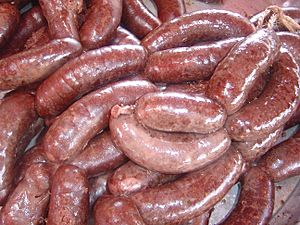
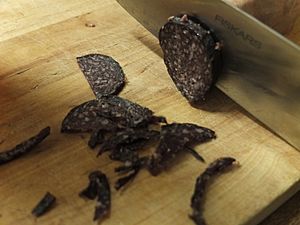
Sausages can be grouped in different ways, depending on what's in them, how they feel, and how they are made. In English-speaking countries, sausages are often put into these main groups:
- Cooked Sausages: These are made with fresh meats and then fully cooked. You can eat them right after cooking, or you need to keep them in the fridge. Examples are hot dogs and liver sausage.
- Cooked Smoked Sausages: These are cooked first, then smoked. You can eat them hot or cold, but they still need to be refrigerated. Kielbasa and mortadella are examples. Some are smoked slowly for days!
- Fresh Sausages: These are made from meats that haven't been preserved before. You must keep them in the fridge and cook them completely before eating. Italian pork sausage and breakfast sausage are fresh sausages.
- Fresh Smoked Sausages: These are fresh sausages that are smoked and cured. They usually don't need to be refrigerated and can be eaten without more cooking. Mettwurst is an example.
- Dry Sausages: These sausages are cured, fermented, and dried. Some are also smoked at the start of the drying process. They are usually eaten cold and can last a long time without refrigeration. Salami and summer sausage are types of dry sausages.
- Bulk Sausage: This is raw, ground, spiced meat sold without a casing. It's also called "sausage meat" or "skinless sausage."
- Vegetarian Sausage: These sausages are made without meat. They might use soya protein or tofu, with herbs and spices. Some vegetarian sausages might contain eggs, so they aren't always vegan.
The special taste of some sausages comes from tiny living things (like good bacteria) that help them ferment during curing.
Other countries have their own ways to classify sausages. Germany, for example, makes over 1200 types of sausage! They sort them into raw, cooked, and precooked sausages.
- Raw Sausages: Made with raw meat and not cooked. They are preserved by a process called lactic acid fermentation and can be dried, brined, or smoked. Most raw sausages last a long time. Salami is a raw sausage.
- Cooked Sausages (Brühwurst): These can include water and special mixers, and they are always cooked. They don't last very long. Cervelat and Weißwurst are examples.
- Precooked Sausages (Kochwurst): Made with meat that's already cooked, but can also have raw organ meat. They might be heated after being put into their casing and only last a few days. Blutwurst (blood sausage) is a precooked sausage.
In Italy, the main types are:
- Raw sausage (salsiccia)
- Cured and aged sausage (salsiccia stagionata or salsiccia secca)
- Cooked sausage (wuerstel)
- Blood sausage (sanguinaccio or boudin)
- Liver sausage (salsiccia di fegato)
- Salami (in Italy, salami means many salame, which are large, cured, fermented, and air-dried sausages)
The United States has a special type called pickled sausages. These are usually smoked or boiled sausages, like hot dogs, that are put into a hot liquid of vinegar, salt, and spices. They are then sealed in Mason jars.
Some countries also classify sausages by the region where they traditionally come from. For example:
- France: Montbéliard, Morteau, Toulouse
- Germany: Frankfurt am Main, Thuringian sausage, Nuremberg
- Hungary: Gyulai kolbász (from Gyula), csabai (from Békéscsaba)
- Poland: Kiełbasa krakowska (from Kraków), toruńska (from Toruń)
- Spain: Chorizo riojano (from La Rioja), morcilla de Burgos
- United Kingdom: Cumberland, Lincolnshire
Sausages Around the World
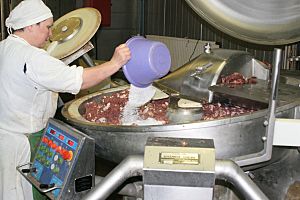
Many countries and regions have their own special sausages. They use local meats and ingredients that are part of their traditional dishes.
Africa
North Africa
Merguez is a red, spicy sausage from North African countries like Morocco and Tunisia. It's also popular in France. Merguez is made with lamb, beef, or both. It's flavored with many spices like sumac (for a tangy taste) and paprika or harissa (a hot chili paste that gives it a red color). It's stuffed into a lamb casing, not pork. Merguez is usually grilled or eaten with couscous. Dried merguez is used to add flavor to stews called tagines. You can also find it in sandwiches.
South Africa
In South Africa, traditional sausages are called boerewors, which means "farmer's sausage." They are made with game meat and beef, often mixed with pork or lamb, and have a good amount of fat. Coriander and vinegar are common seasonings. Boerewors is known for its coarsely ground meat and its long, continuous spiral shape. It's usually cooked on a braai (a type of barbecue).
Droëwors is a dried sausage similar to boerewors. A popular local hot dog is the "Wors roll," which is a hot dog bun with boerewors inside, served with a tomato and onion sauce called seshebo.
Asia
China
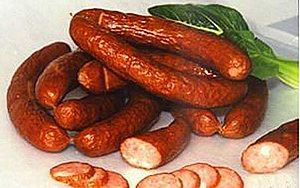
In Harbin, a big city in northern China, they make a European-style smoked sausage called hóng cháng (red sausage). It's like sausages from Lithuania and Poland and tastes more European than other Chinese sausages. This sausage was first made in 1909 by a Russian factory. Harbin-style sausage is now popular all over China, especially in the north.
Lap cheong are dried pork sausages that look like pepperoni but are much sweeter. In southwestern China, sausages are flavored with salt, red pepper, and wild pepper. People often preserve them by smoking and air drying.
Japan

While Japan isn't famous for meat sausages, they do have a fish-based log called kamaboko. It's made from cured ground fish paste called surimi. Kamaboko is often shaped like half-moons on a small wooden plank, and the outside is dyed pink. When sliced, it has a pink edge around a white inside. It's often cut into thin pieces and added to soups, salads, and bento boxes.
Recently, kamaboko has also become a snack food. Like Slim Jims, you can find cheese, sausage, and fish-flavored kamaboko sticks in stores across Japan.
Korea
Sundae is a traditional Korean blood sausage. It's a popular street food, usually steamed or boiled. It's made by stuffing cow or pig intestines with different ingredients. The most common kind has pork blood, cellophane noodles, sliced carrot, and barley inside pig intestines. Other types might use squid or Alaska pollock casings. Sundae can be eaten plain with salt, in stews, or as part of a stir-fry.
Philippines

In the Philippines, sausages are often called longaniza in the north and chorizo in the south. They are usually fresh or smoked. They are known for being either sweet (jamonado) or garlicky (de recado). There are many kinds of sausages in the Philippines, often unique to a specific region, like Vigan longganisa or Chorizo de Cebu. You can also find "skinless sausages," which are ground sausage meat without casings. Most Filipino sausages are made from pork, but some use chicken, beef, or even tuna.
Thailand
Thai cuisine has many types of sausages, some of which are specialties of certain regions. From northern Thailand comes sai ua, a grilled minced pork sausage flavored with curry paste and fresh herbs. Another grilled sausage is sai krok Isan, a fermented sausage from northeastern Thailand. It has a special slightly sour taste. Both sausages are often eaten with sticky rice, fresh vegetables, and a spicy chili paste.
Also very popular in Thailand is naem, a raw fermented pork sausage. This sausage is often used in Thai salads like yam naem. Mu yo is another popular sausage, similar to liverwurst, and is a common snack with a dipping sauce. Kun chiang is a dry and sweet Chinese sausage that's also used in Thai cooking, often in a salad called yam kun chiang. Many modern, factory-made sausages, like hot dogs, are popular snacks sold grilled or deep-fried at street stalls with a sweet and spicy sauce.
Vietnam
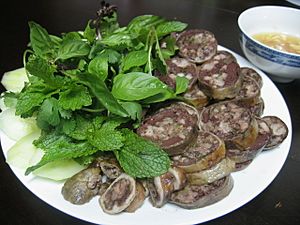
In Vietnam, a popular sausage is giò lụa (or chả lụa), which is a pork sausage. Dồi is a type of blood sausage that is also very common.
Europe
Britain and Ireland
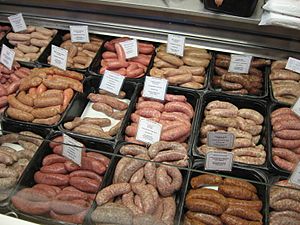
In the UK and Ireland, sausages are a very popular food. British and Irish sausages are usually made from raw pork, beef, or other meats. They are mixed with herbs, spices, and cereals (like breadcrumbs). Many recipes are linked to specific regions, such as Cumberland sausages. They are usually cooked by frying, grilling, or baking. They are typically 10–15 cm long and are twisted into "links" inside a casing, traditionally made from pig intestine.
Because they sometimes burst when cooked, they are often called bangers. A very famous dish is "bangers and mash", which is sausages served with mashed potatoes. Sausages are also a key part of a full English or Irish breakfast. Some sausages follow old regional recipes, while others have new flavors like apple or apricot, or are inspired by European sausages. Vegetarian sausages are also widely available.
A popular snack is the sausage roll, which is sausage meat baked in puff pastry. Sausages can also be baked in a Yorkshire pudding batter to make "toad in the hole", often served with gravy. "Sausage meat" is also sold without a casing for frying or stuffing. Battered sausage, which is a sausage dipped in batter and fried, is sold in fish and chip shops. In England, the saveloy is a pre-cooked sausage, larger than a hot dog, and served hot. It used to be dyed bright red.
Thin sausages called chipolatas are often wrapped in bacon and served at Christmas as "Pigs in Blankets". They can also be eaten cold at parties. Black pudding, white pudding, and Hog's pudding are similar to blood sausages found in other parts of Europe.
There are rules about how much meat must be in sausages in the UK. For example, "Pork Sausages" must have at least 42% pork. Cheaper sausages might not have enough meat to be called "pork sausages" and are just labeled "sausages" or "bangers."
Scotland
Haggis is Scotland's national dish, though it's not called a sausage. A popular breakfast food is the square sausage. It's usually eaten as part of a Scottish breakfast or in a roll. This sausage is made in a rectangular block, and slices are cut off. It's mainly seasoned with pepper and is rarely seen outside Scotland. Other Scottish sausages include black pudding, which is like German and Polish blood sausages. Stornoway black pudding is very famous. Another popular sausage is the red pudding, often deep-fried in batter and served with chips from chip shops.
Germany
Germany is famous for its many types of sausages! Some well-known German sausages include Frankfurters/Wieners, Bratwürste, and Bockwürste. Currywurst, which is sausages with curry sauce, is a very popular fast food in Germany.
Loukániko (Greek: λουκάνικο) is the common Greek word for pork sausage. Its name comes from ancient Roman cooking.
Hungary
Hungarian sausages, when smoked and cured, are called kolbász. Different types are named after their regions, like gyulai and csabai sausage. Hungary also has boiled sausages called "hurka." The most common are rice liver sausage ("Májas Hurka") and blood sausage ("Véres Hurka"). These are mixed with rice or bread and spices like pepper, salt, and marjoram.
Italy
Italian sausages (salsiccia) are often made of pure pork, and sometimes beef. In Southern Italy, fennel seeds and chili are common spices. In central and northern Italy, black pepper and garlic are used more often.
A different popular sausage in Italy is salame (many are called salami). It's made from coarsely ground meat (pork or beef) mixed with fat, salted, and dried. Spices are added just like for salsiccia. Salami are ready to eat when you buy them. They are usually sliced thinly and eaten cold.
Malta
Maltese sausage (Maltese: Zalzett tal-Malti) is made of pork, sea salt, black peppercorns, coriander seeds, and parsley. It's short and thick and can be eaten grilled, fried, stewed, steamed, or even raw when fresh.
Nordic countries

Sausages in Nordic countries (like Denmark, Norway, Sweden, Iceland) are usually made of 60–80% very finely ground pork. They are lightly spiced with pepper, nutmeg, or allspice. Water, fat, and potato starch are often added.
Almost all sausages are pre-cooked in factories. Consumers then fry them or warm them in hot water. In Denmark, hot dog stands are everywhere, and some people think pølser (red sausages) are a national dish. The most noticeable thing about Danish boiled sausages is their bright-red color. They are also called wienerpølser.
The traditional Swedish falukorv is a sausage made of pork and beef or veal with potato flour and mild spices. It's also red-dyed and about 5 cm thick. It's usually baked in the oven or sliced and fried. Other Swedish sausages include prinskorv and isterband. These are often eaten with mashed potatoes or root vegetable mash instead of bread.
In Iceland, lamb can be added to sausages, giving them a special taste. Horse sausage and mutton sausage are also traditional, though less popular now. Liver sausage and blood sausage are also common foods in Iceland.
Poland
Polish sausages, called kiełbasa, come in many styles like swojska, krajańska, and szynkowa (a ham sausage). Sausages in Poland are usually made of pork, rarely beef. Sausages with low meat content are seen as lower quality. Because of the climate, sausages were traditionally preserved by smoking rather than drying, like in warmer countries.
Poland has been great at making sausages since the 14th century. This was partly because kings would give game meat from hunting trips as gifts. The raw meat was often delivered in winter, but processed meat was available all year. Early Italian, French, and German influences also played a role in Polish sausage making.
Portugal and Brazil
Embutidos (or enchidos) and linguiça generally contain chopped meat, especially pork. They are seasoned with herbs and spices like pepper, red pepper, garlic, rosemary, and thyme.
Spain
In Spain, fresh sausages (salchichas), which are cooked, and cured sausages (embutidos), which are eaten uncooked, are two different groups. Cured sausages include chorizo, salchichón, and sobrasada. Blood sausage (morcilla) comes in both cured and fresh types. They are made with pork meat and blood, often with rice, garlic, paprika, and other spices. There are many regional kinds, and they are usually fried or cooked in stews.
Fresh sausages can be red or white. Red sausages have paprika (pimentón) and are usually fried. They might also have garlic, pepper, or thyme. A popular red sausage is txistorra, a thin, long paprika sausage from Navarre. White sausages don't have paprika and can be fried or boiled in wine.
Switzerland
The cervelat, a cooked sausage, is often called Switzerland's national sausage. There are also many other special regional sausages.
Latin America
In most of Latin America, a few basic types of sausages are eaten, with small differences in each recipe. These include chorizo (raw, not dried like in Spain), longaniza (similar to chorizo but longer and thinner), morcilla (blood sausage), and salchichas (like hot dogs). Beef is often used more than in the pork-heavy Spanish versions.
Argentina and Uruguay
In Argentina and Uruguay, many sausages are eaten. As part of the traditional asado (barbecue), chorizo (beef and/or pork with spices) and morcilla (blood sausage) are the most popular. Both came from Spain. A local type is the salchicha argentina, which is like chorizo but thinner. There are also many salami-style sausages. The salame tandilero from Tandil is very popular. Other types include longaniza and cantimpalo.
Vienna sausages are eaten as a snack or in hot dogs (called panchos), usually with different sauces. Liverwurst is also common.
Chile
Longaniza is the most common type of sausage in Chile. The Chilean version is made of four parts pork to one part bacon, seasoned with garlic, salt, pepper, cumin, oregano, paprika, and chili sauce. The cities of Chillán and San Carlos are known for having the best longanizas.
Another traditional sausage is the prieta, which is Chile's version of blood sausage. In Chile, it has onions, spices, and sometimes walnuts or rice. It's usually eaten at asados or with boiled potatoes. "Vienesa"s (Vienna sausages) are also very common and are mainly used in the completo, which is the Chilean hot dog.
Colombia
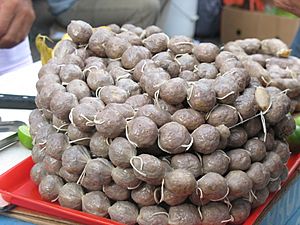
A grilled chorizo served with a buttered arepa is a very common street food in Colombia. Butifarras Soledeñas are sausages from Soledad, Atlántico. Besides the usual Latin American sausages, dried pork sausages are eaten cold as a snack, often with beer. These include cábanos (salty, short, thin) and butifarra (spicier, shorter, fatter, and often eaten raw with lemon juice).
Mexico
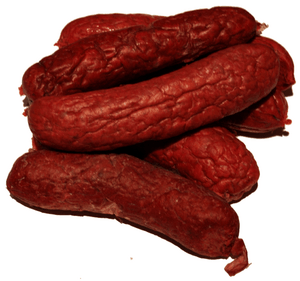
The most common Mexican sausage is chorizo. It's fresh and usually deep red. Some chorizo is so loose that it crumbles out of its casing. This crumbled chorizo is a popular filling for torta sandwiches, eggs, and tacos. Salchichas, longaniza (a long, thin, lightly spiced pork sausage), and moronga (a type of blood pudding) are also widely eaten.
El Salvador
In El Salvador, chorizos are very common. The ones from the city of Cojutepeque are especially famous. The sausage links are often separated by corn husks tied in knots. Like most chorizos in Latin America, they are sold raw and must be cooked.
North America
North American breakfast or country sausage is made from uncooked ground pork, breadcrumbs, and salt mixed with pepper, sage, and other spices. It's sold in stores in a large plastic casing or in links. It can also be found without a casing. This sausage is similar to English-style sausages and has been made in the United States since colonial times. It's often sliced into small patties and pan-fried, or cooked and crumbled into scrambled eggs or gravy.
Several types of meat-and-grain sausages were developed in the US. Scrapple is a pork-and-cornmeal sausage from the Mid-Atlantic States. Goetta is a pork-and-oats sausage from Cincinnati. Livermush, from North Carolina, is made with pork, liver, and cornmeal or rice. These were all created by German immigrants.
In Louisiana, there's a special type of sausage called andouille. Unlike the original French version, Louisiana andouille is made mostly from pork butt, not tripe. It's very spicy with cayenne and black pepper. This type is known as Tasso ham and is often used in Cajun and Creole cooking. It's traditionally smoked over pecan wood or sugar cane. In Cajun cooking, boudin is also popular.
Hot dogs, also called frankfurters or wieners, are the most common pre-cooked sausage in the United States and Canada. Another popular type is the corn dog, which is a hot dog deep-fried in cornmeal batter and served on a stick. In New Jersey, pork roll is a common regional sausage, usually sliced thin and grilled for breakfast.
Other popular ready-to-eat sausages, often eaten in sandwiches, include salami, American-style bologna, liverwurst, and head cheese. Pepperoni and Italian sausage are popular pizza toppings.
Oceania
Australia
Australian sausages, often called "snags," have traditionally been made with beef, pork, and chicken. Recently, meats like kangaroo (which has less fat) have also been used. English-style sausages come in two sizes: thin (like an English breakfast sausage) and thick. These sausages are popular at barbecues and can be bought from any butcher or supermarket. Devon is a spiced pork sausage similar to Bologna sausage. It's usually made in a large size, sliced thinly, and eaten cold in sandwiches.
Mettwurst and other German-style sausages are very popular in South Australia. They are often made in towns like Hahndorf because many German immigrants settled there. Mettwurst is usually sliced and eaten cold on sandwiches or as a snack. A local type of cabanossi, developed by Italian immigrants, is a popular party snack.
New Zealand
Sausage rolls are a popular snack and party food in New Zealand, as are saveloys and cheerios. Traditional sausages, similar to English bangers, are eaten throughout the country. These are usually made of finely ground beef or mutton with breadcrumbs, lightly spiced, and put into an edible casing that crisps when fried. They can be eaten for breakfast, lunch, or dinner. In recent years, many international and unique sausages have also become widely available in New Zealand.
Images for kids
-
A full Scottish breakfast with black pudding, Lorne sausage, toast, fried mushrooms, and baked beans
-
Mettwurst, a strongly flavored German sausage
-
Ryynimakkara, a Finnish groat sausage
-
Sausage in Curitiba, Brazil
-
Hot dog, a common pre-cooked sausage in the United States and Canada
-
Salami, a cured sausage
-
Vegetarian sausages with baked beans on toast
-
Sausages after roasting
-
A sausage sandwich with egg and ketchup
-
A salmon sausage
See also
 In Spanish: Salchicha para niños
In Spanish: Salchicha para niños


